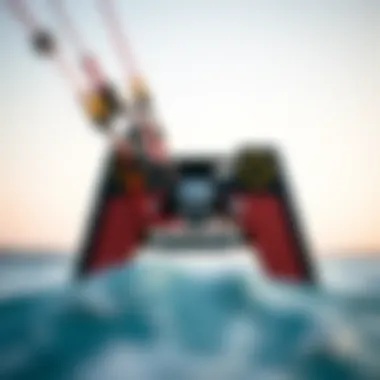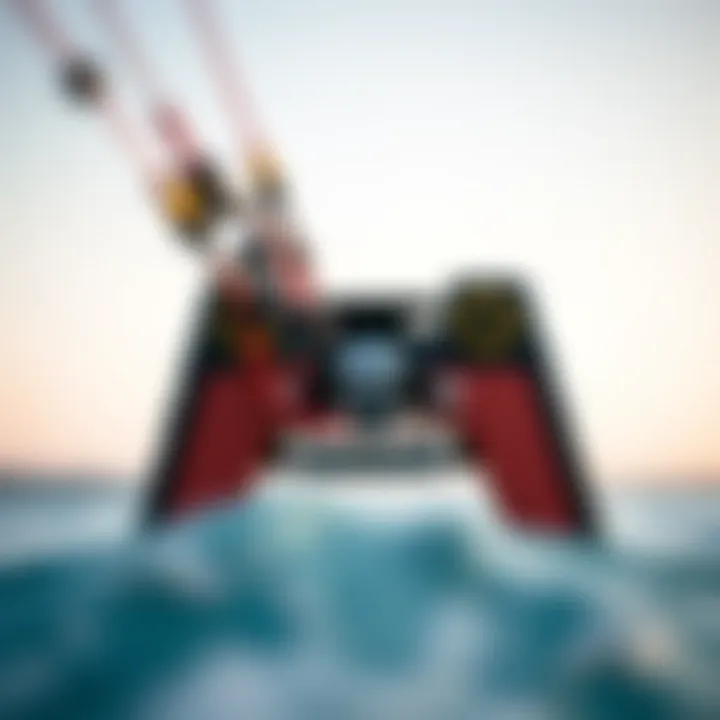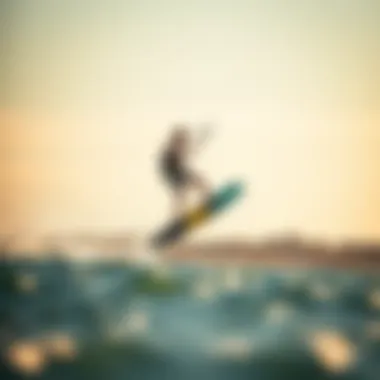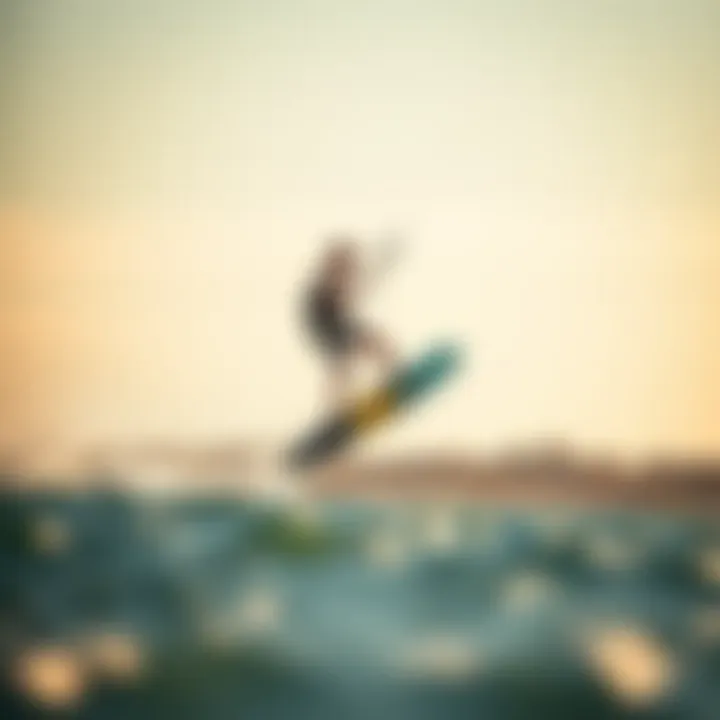Hydrofoil Kitesurfing: An In-Depth Exploration


Intro
Hydrofoil kitesurfing represents a transformation in the world of kiteboarding, shaping a new experience that riders have come to relish. At its core, hydrofoiling uses a board that is elevated above the water via a hydrofoil, which allows the rider to glide smoothly while reducing drag. This innovation not only enhances speed and efficiency but also opens up opportunities for riding in lighter winds.
The allure is undeniable—riders claim the sensation of flying above the water’s surface is unlike anything else. Whether you are a seasoned kiteboarder or someone new to this thrilling sport, understanding the mechanics, techniques, and gear involved is essential for an enjoyable experience. Let’s dive deeper into the various components that shape this maritime adventure.
Gear and Equipment
Equipping oneself for hydrofoil kitesurfing requires both a keen understanding of essential gear and the high-performance equipment suited for more experienced riders. Each piece not only plays a role in safety but also greatly influences your overall experience.
Essential Kiteboarding Gear for Beginners
Starting with the basics, beginners should focus on essential gear that provides stability and confidence on the water. Here’s a run-down of what you’ll need:
- Kite: Look for a responsive and easy-to-handle kite. Brands like North and Duotone offer beginner-friendly options that help learners get acquainted with the basics of kiting.
- Control Bar: A simple control bar with adjustable settings allows for easy maneuverability.
- Wetsuit: While thin for warmer waters or thicker for chillier climates, a good wetsuit is key to comfort and protection.
- Safety Gear: A helmet and impact vest can protect against falls and mishaps during the learning process.
- Hydrofoil Board: Since hydrofoils come in various shapes and sizes, a larger, more stable beginner board can foster confidence as you master kiting.
Advanced Equipment for Experienced Riders
Once you have grasped the fundamentals, you might want to explore advanced gear to enhance your skills and riding experience:
- Performance Kite: Choose a kite designed for speed and responsiveness. The Ozone Chrono, for example, is popular among advanced riders for its performance in various wind conditions.
- High-Aspect Foil: These are designed for speed, perfect for those looking to get the most out of their hydrofoil.
- Custom Board: Tailoring your board to your weight and style can make a significant difference in ride quality.
- Specialized Harnesses: Look for harnesses that offer comfort and support for extended rides on the hydrofoil.
Techniques and Tips
Mastering hydrofoil kitesurfing goes beyond equipping yourself with the right gear. The techniques you employ greatly define your proficiency and enjoyment on the water.
Basic Riding Techniques for Newbies
Newcomers should prioritize mastering the following:
- Balancing: Start by getting comfortable standing on the board while being towed by the kite.
- Starting Position: Your stance should be wide with knees slightly bent, making it easier to adjust to the shifting balance.
- Foiling Takeoff: Focus on gradual pressure on the back of the board to lift the hydrofoil from the water surface.
Expert Tricks to Elevate Your Skills
Once arrivals feel confident, they can branch out into more advanced maneuvers, including:
- Jumps: Bouncing off the water while controlling the kite can lead to impressive aerial stunts.
- Switch Riding: Mastering this technique allows one to ride both directions with ease.
- Carving Turns: Learning to engage the foil into turns significantly improves maneuverability and control.
As you set your sights on hydrofoil kitesurfing, remember that every rider’s journey is filled with unique challenges and triumphs. The thrill of skimming over the waves does not come without practice, but with the right gear and techniques, the rewards can be immense. What encompasses much of the excitement is not just the speed or the tricks—it's the freedom of harnessing nature's elements. As you prepare to embark on this journey, familiarizing yourself with gear, techniques, and safety considerations will immensely enrich your experience on the water.
"The beauty of kitesurfing with a hydrofoil lies in its ability to blend the rush of flying with the serenity of gliding over the water."
For further details, consider referring to Wikipedia and online community discussions on places like Reddit.
Getting involved and learning from experienced kitesurfers can also be tremendously beneficial as you take your first steps into hydrofoil kitesurfing.
Prolusion to Hydrofoil Kitesurfing
Hydrofoil kitesurfing stands at the forefront of modern kiteboarding, marking a distinct shift from traditional methods of riding. This innovative sport incorporates a specialized hydrofoil, allowing riders to glide above the water’s surface with remarkable speed and maneuverability. Through its unique mechanics, hydrofoil kitesurfing sheds light on the essence of freedom and fluidity in water sports, enabling enthusiasts to embrace the thrill of riding on a new level. Understanding this, the significance of hydrofoil kitesurfing extends beyond mere fun; it embodies advancements in technology and skill that can enhance the entire kiteboarding experience.
Definition and Origins
The concept of hydrofoil kitesurfing can be traced back to the early innovations in surfboards and sailing vessels. At its core, a hydrofoil is an appendage that sits below the water, lifting the board above the surface through the hydrodynamic principles that come into play as speed increases. This lift allows riders to experience a sensation akin to flying, with reduced drag and increased efficiency.
Emerging in the late 20th century, hydrofoils were initially experimented with in the realm of sailing before becoming integrated into the kiteboarding culture. The first hydrofoil kiteboards appeared in the early 2000s, rapidly gaining traction as enthusiasts recognized their potential. Over time, these boards have received continuous improvements in design, making them more accessible, stable, and user-friendly. As a result, today’s riders can experience a seamless performance, even in the most challenging of conditions.
The Evolution of Kiteboarding
Kiteboarding itself has undergone significant transformation since its inception. Starting with simple designs in the 1980s, it quickly developed into a global phenomenon. The introduction of hydrofoils represents just one chapter in this dynamic story. It reflects how kiteboarding has adapted, keeping pace with technological advances and rider demands.
Initially characterized by wide boards that skimmed over the surface of the water, kiteboarding has shifted toward more high-tech options. Riders are now seeking gear that enhances their performance, and hydrofoil kitesurfing fits the bill perfectly by offering:
- Greater lift
- Improved speed
- Enhanced agility
As kiteboarding evolved, so too did the community around it. Clubs and events sprouted up worldwide, showcasing talent and encouraging new riders. Hydrofoil kitesurfing, with its distinct characteristics, soon carved out a niche within this vibrant culture, becoming a sought-after addition for adventurous kiteboarders eager to push boundaries.
Understanding the Hydrofoil
To truly appreciate the thrill of hydrofoil kitesurfing, one first needs to grasp the mechanics and intricacies of the hydrofoil itself. This unique equipment plays a crucial role in transforming the kitesurfing experience, allowing riders to glide gracefully above the water's surface rather than churning through it. This section dissects both the design and the various types of hydrofoils, spotlighting the elements that contribute to their functionality and appeal.
Mechanics of Hydrofoil Design
At its core, a hydrofoil comprises a wing-like structure attached to a sturdy mast, which in turn links to a board. When the rider gains speed, the hydrofoil generates lift due to pressure differences on its upper and lower surfaces, elevating the board above the water. This lift is pivotal in reducing drag and enabling the rider to access higher speeds and smoother rides. The design principles behind these foils resemble those in aviation, where understanding aerodynamics is essential.
An essential feature of a hydrofoil is its angle of attack; this is the angle between the wing's chord line and the flow of water. Adjustments to this angle significantly affect lift and drag, making it critical for riders to understand. The stability of a hydrofoil also hinges on its geometry – a well-thought-out design can mean the difference between a smooth ride and chaotic tumbling. Thus, the marriage of engineering and rider skill is vital for mastery in hydrofoil kitesurfing.
Types of Hydrofoils
Foil Shape
The shape of the foil profoundly influences performance. Among different designs, a thicker profile may provide more lift at lower speeds, making it ideal for beginners or those looking to cruise leisurely. Conversely, a thinner profile excels at slicing through water at higher speeds, favoring more advanced riders. One popular choice is the high-aspect ratio foil, which is recognized for its efficiency in maintaining speed while requiring less effort to ride. This can significantly reduce fatigue over longer sessions.
"Different foil shapes cater to various riding styles and conditions, allowing riders to tailor their equipment to their preferences."
Each shape comes with its trade-offs; while a thicker foil might lift quicker, it could sacrifice top-end speed when compared to its sleek counterparts. Thus, it is important for riders to consider their skills and the typical conditions they encounter.
Materials Used


The materials used in hydrofoil construction greatly affect both performance and durability. Common materials include aluminum, which is favored for its strength-to-weight ratio, and carbon fiber, known for being lightweight yet robust. A key consideration here is the cost, as carbon fiber foils are typically pricier but offer superior flex and responsiveness. This means that a higher initial investment might lead to enhanced riding experiences.
When examining the advantages, carbon fiber provides unmatched stiffness and can facilitate more agile maneuvers. However, sticking to aluminum foils doesn’t mean skimping on quality; they remain a popular choice for many everyday riders due to their resilience and lower price point.
Size and Scale
Choosing the right size and scale of hydrofoil is essential. The mast's length can significantly influence the ride; shorter masts provide stability and ease of use but limit the height above water while longer masts allow for higher lifts but require more precision from the rider. Most riders find a mast between 70 and 90 centimeters to be a suitable compromise for diverse conditions.
The wing size also matters. Larger wings deliver more lift, making them suitable for slower speeds and choppier waters, while smaller wings excel at higher speeds—important when hitting the waves at speed. Such size considerations must align with the rider's weight and experience level to optimize the overall kitesurfing encounter.
Benefits of Hydrofoil Kitesurfing
Hydrofoil kitesurfing introduces a paradigm shift in the kiteboarding landscape, offering an array of advantages that entice both novices and seasoned riders. The most notable benefits include enhanced speed and efficiency, reduced water resistance, and impressive versatility in varied conditions. Understanding these elements can elevate the riding experience, unlocking potential for greater enjoyment and performance.
Improved Speed and Efficiency
One of the most compelling reasons to embrace hydrofoil kitesurfing is the remarkable speed and efficiency it affords. When you have a hydrofoil in play, the board lifts above the water, reducing drag significantly. The hydrofoil operates much like an airplane wing, creating lift as it moves through water.
"With hydrofoils, you can find yourself gliding effortlessly, almost like flying over water!"
This lift not only augments your speed but also allows riders to maintain momentum even in lighter winds. Consequently, hydrofoil kitesurfers can traverse longer distances with less effort, pushing the boundaries of what was once thought possible in kiteboarding. Using this tech, a simple gust can propel you forward with the grace of a gazelle on an open plain.
Reduced Water Resistance
Water resistance is a significant hurdle for traditional kiteboarders. The very act of cutting through the water generates drag, which can slow down even the most experienced riders. Hydrofoils sidestep this issue, providing a unique solution by lifting the board above the surface and minimizing contact with the water.
When a rider is airborne, the hydrofoil essentially eliminates much of the friction associated with traditional riding. This translates to quicker accelerations and the ability to ride in conditions that would typically be deemed unfit for conventional kiteboarding. Imagine carving through waves and feeling less resistance than a knife through butter. It’s not just a convenience; it’s a game-changer.
Versatility in Varied Conditions
The landscape of wind and water is ever-changing, with conditions that can vary widely from day to day. Unlike traditional boards that may struggle in rapidly shifting environments, hydrofoil kitesurfing shines in a multitude of conditions. Whether it’s a light breeze or choppy waves, hydrofoils offer the flexibility needed to adapt.
For instance, with hydrofoils, riders can glide smoothly over choppy water which would otherwise be challenging for a standard kiteboard. Additionally, they can tap into lighter winds that might leave others grounded. Riders are not shackled to the whims of Mother Nature; they gain a freedom that transforms routine sessions into adventurous outings.
In summary, the benefits of hydrofoil kitesurfing lay the groundwork for a thrilling experience unlike any other in the kiteboarding world. Its potential for superior speed, minimal resistance, and adaptability illustrates why so many are turning their sights – and boards – toward hydrofoils. For more information on kiteboarding advancements, refer to Wikipedia or Britannica.
Explore the joys of this cutting-edge sport and discover how hydrofoiling can take your kiteboarding to new heights!
Technique and Skill Development
In the world of hydrofoil kitesurfing, mastering technique and skill development is crucial, not just for enhancing performance but also for ensuring safety and enjoyment on the water. Whether you’re a budding enthusiast or a seasoned kiteboarder looking to switch gears, understanding the nuances of this sport will make all the difference.
Starting out with Hydrofoils
Starting with hydrofoils can feel a bit like jumping into the deep end without knowing how to swim. It’s distinctly different from traditional kiteboarding in terms of balance and board dynamics. One must first get accustomed to the sensation of defying gravity as the hydrofoil lifts the board out of the water. Practicing on a flat, calm day is essential. The less turbulence, the easier it is to feel the board’s response beneath you. Each ride serves as a unique learning experience, gradually building confidence and skill.
Essential Riding Techniques
Balance and Stance
Balance is the linchpin of successful riding on a hydrofoil. Unlike standard boards, where the rider can distribute weight evenly, hydrofoiling requires greater precision. The key characteristic of a solid balance comes from a centered stance—your feet should be shoulder-width apart, knees slightly bent, and lower back engaged.
The takeaway is that a proper stance not only keeps you upright but also enhances control. As you rise and fall with the swell, this attention to balance becomes increasingly crucial, especially when transitioning between water and air. A downside of neglected balance could lead to scrapes or, worse, a lack of control over the foil’s movement, which can be thrillin’ but also risky.
Controlling the Kite
Controlling the kite ties back to the art of finesse. The unique feature of effective kite control lies in the ability to steer with subtlety rather than brute force. Adjusting your pull and the angle of attack makes all the difference in maintaining lift and speed.
Why it’s popular amongst riders is simple: good control allows for greater efficiency in flying the kite, which translates to more fluid movement over the water. If this notably complex facet of hydrofoil kitesurfing isn't mastered, riders could face challenges in harnessing wind power, leading to abrupt stops or frustrating stalls.
Edge Control
Edge control goes hand-in-hand with maintaining speed and stability. You’ll want to have a precise approach, otherwise, an untimely shift can throw you off balance. Learning to use the rail of the hydrofoil board helps in steering and turning. It’s essentially riding the edge of science here.
The core advantage is that strong edge control contributes to carving out turns and performing maneuvers with elegance. However, as with anything, it needs practice. If too much weight is put on one side, it could result in a drop back into the water, wasting precious time.
Advanced Maneuvers
As your skills sharpen, the desire to push boundaries often emerges, making advanced maneuvers a thrilling aspiration.
Jumps and Tricks
Jumping with a hydrofoil isn’t just about the height; it’s about timing and technique. The kick-off requires an understanding of the kite's power and it's essential to spot the swell just right. A key characteristic of jumps in hydrofoil kitesurfing is the combination of momentum and control.
Innovative riders often experiment with their tricks, using them as a way to express individuality. Yet, poor execution can lead to falls or injury, making practice essential in this exhilarating domain.
Turning Techniques
Mastering turning techniques is indispensable, especially when aiming to transition quickly between different movements. The uniqueness of turning on a hydrofoil lies in how balance shifts and how the rider engages with both the board and the kite. Having a keen awareness allows for smoother transitions, which is vital when navigating wind patterns.
However, a rushed or careless turn can result in sharp corrections that may throw you off-balance or even wipe you out completely.
Transitions
Transitions revolve around the fluid movement from one direction to another, and it requires a complex interplay of balance, kite control, and speed management. The hallmark of a good transition lies in its seamlessness; nothing feels more satisfying than gliding smoothly with minimal disruption.
For those who master this, it can lead to more dynamic riding experiences, but it should be noted that allowing too much time between maneuvering doesn’t just spoil the flow—it might also raise your chances of getting upended.


A comprehensive grasp of technique and skills in hydrofoil kitesurfing can ultimately mean the difference between a fun outing and a frustrating one. Balancing practice with safety assists riders in not only perfecting their craft but also fostering a genuine appreciation for this captivating sport.
Safety Considerations
When it comes to hydrofoil kitesurfing, safety isn't just a good practice; it is an imperative. The exhilarating feeling of gliding above the water's surface can quickly become overshadowed if proper precautions are not taken. From understanding potential risks that come with the sport to gearing up with the right equipment, ensuring your safety while hydrofoiling sets the stage for a more enjoyable experience. Let's dive into the specifics, illuminating the pivotal aspects of safety considerations with the kind of detail that equips both the novice and the seasoned rider.
Understanding Hydrofoil Risks
Engaging in hydrofoil kitesurfing involves dealing with unique risks inherent to both kitesurfing and foiling itself. One notable risk is the peril of injury from the hydrofoil blade, especially during falls or collisions. The sharp edges of the foil can lead to significant cuts or impacts that may range from minor abrasions to more severe injuries. Another concern is becoming unbalanced and crashing into the water at high speed; it can lead to unexpected hazards. Also, there are environmental risks to account for, like strong currents or changing weather conditions, which could unexpectedly affect control.
Educating oneself about these risks is vital. This involves extensive observation of water conditions, maintaining proper distance from other surfers, and awareness of one's balance on the board. While it's impossible to eliminate every danger, recognizing and preparing for these incidents can significantly enhance safety.
Essential Safety Gear
Helmets and Impact Vests
When it comes to safety gear for hydrofoil kitesurfing, helmets and impact vests take center stage. These items are essential tools that can guard against head injuries and upper body impacts. A helmet, in particular, protects your head from sudden falls or accidents, such as when a rider loses control and falls. High-quality helmets designed for watersports are often constructed with shock-absorbing materials, which can provide critical protection in a wipeout.
Impact vests serve a dual purpose; they provide buoyancy while cushioning your body against impact. This added layer reduces the sting of a fall, especially if you crash hard against the water. Their buoyancy features can play a critical role if you find yourself winded after a tumble. Beneficially, wearing them allows for greater confidence while trying those audacious tricks. However, it’s important to ensure that any vest is snug fitting, as a loose vest may actually hinder movement rather than aid it.
Wetsuits and Booties
Wetsuits and booties are equally significant when it comes to staying safe and comfortable on the water. A wetsuit acts as your first line of defense against cold water exposure, which can sap your strength and hinder your performance. Select a wetsuit designed for movement; flexibility is key. The right fit also serves to prevent water from flooding in, keeping you warm even in cooler conditions.
Booties are another unsung hero of water safety. They provide foot protection against sharp reef or rocks while ensuring you can maintain grip on your board. These protective shoes greatly contribute to your balance, especially important when mastering tricks or shifting your weight. However, they must fit well, or they may lead to blisters, which, in turn, might keep you off the water as you heal.
Self-Rescue Techniques
Understanding how to perform self-rescue techniques is critical for any kitesurfer, especially those navigating the unpredictable nature of hydrofoiling. Familiarizing oneself with methods to reboard one’s board and manage the kite safely after a fall can make a world of difference in unexpected situations. A key aspect of this is learning to body drag back to your board; using the wind in your kite to control your movement can be a lifesaver. Additionally, being versed in ways to disengage your kite and prevent it from flying away or crashing can greatly reduce risks during a malfunction.
Adopting these practices enhances safety significantly, adding confidence to your riding and allowing for a better overall experience on the water.
Choosing the Right Equipment
Choosing the right equipment is paramount in hydrofoil kitesurfing. The sheer exhilaration of gliding above the water can only be fully realized when the rider has the optimal setup. Poor equipment choices can not only dampen the experience but might also pose safety risks. In this section, we delve into the specifics of selecting hydrofoil boards and kites—a critical endeavor for anyone keen on making the most of their time on the water.
Selecting a Hydrofoil Board
When it comes to hydrofoil kitesurfing, the board you choose significantly influences your performance. Two key features dominate the decision: board size and volume, and board shape and design.
Board Size and Volume
The size and volume of a hydrofoil board are essential components affecting buoyancy and stability. A larger board typically offers better stability, especially for beginners who might still be mastering balance. This is because a board with more volume tends to float better, thus making it easier to get up on the foil.
Conversely, those with more experience often prefer a smaller board since it affords quicker maneuverability and a more immediate response to riding conditions. It's vital to consider your weight as well; generally, heavier riders should opt for boards with larger volume to maintain adequate floatation.
The unique aspect of considering size and volume is that it shapes your overall ride experience. An oversized board can be cumbersome in high winds, while a board that is too small can lead to instability. It's about finding that sweet spot. A well-chosen board helps create a smoother ride, enhancing your ability to perform jumps and tricks.
Board Shape and Design
The shape and design of a hydrofoil board dictate not only aesthetics but also functionality. Most riders are drawn to the sleek, minimalist designs that promise enhanced performance. For instance, boards with a narrower nose cut through the waves better, which can be advantageous in choppy waters.
Additionally, the concave shape can improve your grip on the water, providing much-needed traction as you skim across the surface. However, aesthetics aside, it's crucial to think about the trade-offs. A board that's too pointed may be prone to submerging, while a wider design might result in a slower top speed.
Kite Selection for Hydrofoiling
Selecting the right kite can make or break your hydrofoil kitesurfing adventure. Two major aspects to consider here are kite type and kite size along with wind range.
Kite Type
The type of kite you choose plays a significant role in how well it performs on a hydrofoil. There are generally two main types: inflatable kites, which offer excellent stability and durability, and foil kites, which are usually lighter and pack smaller, but can be trickier to handle in turbulent winds.
For hydrofoilers, inflatable kites are more advantageous. Their design allows for greater control, especially when you're transitioning between different wind conditions. An inflatable kite can also provide a more gradual power delivery, giving you the ability to ride at slower speeds without losing lift.
The caveat is that while inflatable kites tend to be more user-friendly, they are bulkier when transporting. Hence, whether you prioritize ease of use or portability will influence your choice.
Kite Size and Wind Range
Kite size directly correlates with your success on the water; choosing the appropriate size based on wind conditions is critical. Larger kites are better suited for lighter winds, while smaller kites shine in stronger winds. But it's more than just matching the kite size with the wind strength. A larger kite can provide increased lift, which is essential for learning and practicing on a hydrofoil.
However, using a larger kite in high winds can lead to a challenging experience, as it might become overly powerful, making it harder to control. This duality calls for a nuanced understanding of local wind patterns and one's own skill level.
To simplify, get a kite that complements your weight and riding style. Knowing your local wind conditions makes it easier to make informed choices about size, keeping safety and performance in mind.
"Selecting the right equipment is not just about buying what's popular; it's about finding what works best for you and the conditions you face."
When you put all these elements together, you formulate a personalized set-up that maximizes both safety and enjoyment, fundamentally enhancing the overall experience of hydrofoil kitesurfing.
Wave Conditions and Hydrofoiling
When it comes to hydrofoil kitesurfing, the understanding of wave conditions is paramount. This is not just about how the water looks, but deeply about how different variables can greatly affect your ride. You could have the best equipment, but if the conditions aren’t right, you might find yourself struggling for balance more than catching waves.
Assessing Wind Conditions
Wind is the soul of any kitesurfing adventure. Without it, you're left with a board and a paddle, not much fun. Assessing wind conditions means more than simply checking your weather app; it entails being adept at reading how the wind interacts with the water.
A few key points when evaluating:


- Wind Speed: Ideal ranges generally fall between 10 to 25 knots for beginners on hydrofoils. Too little wind, and you’re left sitting on the water, too much, and it can turn into quite the wild ride.
- Wind Direction: Onshore, offshore, or cross-shore wind can drastically change your session's dynamics. Offshore wind, while often smoother, can put you farther from the shore and potentially present a challenge when returning.
- Wind Consistency: Fluctuating winds are a kiter's nemesis. Picking days where the wind is steady can make the difference between a fun session and a frustrating one.
Taking time to observe the shifts in wind can help you predict how your riding might go. Just think of it like reading the lay of the land before a big adventure.
Identifying Suitable Water Bodies
Not all waters are created equal in the realm of hydrofoil kitesurfing. Opting for the right water body makes the experience more pleasurable and safer. Look for locations that provide that magical combination of depth and smoothness.
Some considerations include:
- Depth: Hydrofoils need a certain depth to function correctly. If you're riding in shallow waters, you'll spend more time worrying about hitting the ground than enjoying your session. Generally, water should be at least a meter deep.
- Surface Conditions: Glassy water is the golden standard. Choppy, wavy surfaces can be a pain and can hinder balance and control. It’s like walking on a trampoline versus solid ground; one is easier, the other not so much.
- Debris and Hazards: Always check for rocks, jellyfish, or other floating junk that could spoil your fun. Not only can they damage your foil, but they can also be dangerous. Knowing your riding area is key; don’t jump in blind.
Adjustment Techniques for Conditions
Even with the best preparation, conditions will change. Being adaptable is part of being a successful kitesurfer. Here are a few adjustments you can make to handle varying conditions:
- Tuning Your Equipment: Adjusting the settings of your kite can help you navigate tougher winds. Lowering the trim can make it easier to manage higher winds.
- Foot Positioning: Shifting your feet can alter the dynamic of the ride. Closer to the tip may help you steer better in strong winds.
- Maintaining Low Speed: In rougher waters, keeping your ride smooth often means slowing down. Progressing too fast can lead to losses in balance, making it a dizzying affair.
"Adaptability is key in kitesurfing, much like in life. You can’t control the winds, but you can learn to ride them."
Understanding wave conditions takes experience and patience, but the benefits are worth it. It’s not just about avoiding disaster; it’s about enhancing your entire riding experience. This deeper connection with your environment will help you become not just a better rider, but also a more mindful one.
Environmental Considerations
In the realm of hydrofoil kitesurfing, where thrill meets tranquility, the environmental impact of our sport cannot be overlooked. As we ride the waves and harness the winds, it's crucial to reflect on how these activities affect our precious marine ecosystems. Understanding environmental considerations is not just about protecting nature; it’s about ensuring that the very sport we adore can flourish for future generations.
Selecting appropriate kiteboarding locations is fundamental. It’s vital to be mindful of the local wildlife and their habitats. Many coastal areas are home to various types of marine life, including fish, birds, and mammal species that can be sensitive to disturbances. Adhering to no-wake zones and avoiding fragile environments protects these creatures. By doing so, we contribute to the sustainability of our aquatic playgrounds, allowing the underwater world to thrive alongside our activities.
Impact on Marine Life
When it comes to water sports, hydrofoil kitesurfing holds a unique position. The rapid ascent above water reduces direct interaction with marine habitats, minimizing the risk of damaging delicate ecosystems often found in shallower waters. Yet, there are still considerations to keep in mind:
- Propeller Wash: The turbulence created by our boards and hydrofoils can stir up sediment, affecting the clarity of waters and habitats for aquatic life.
- Noise Pollution: Many marine creatures rely on sound for communication and navigation. The noise generated by our kites and boards can disrupt their natural behaviors, which is especially concerning for species like dolphins or whale populations.
- Habitat Avoidance: Certain areas may be vital to vulnerable species during their breeding or feeding seasons. Being conscious of these seasons is essential to minimize the impact on marine life.
To gain deeper insights on this topic, websites like NOAA and Marine Conservation Society provide extensive resources.
Responsible Riding Practices
As kitesurfers and outdoor enthusiasts, balancing our enjoyment and our responsibility to the environment is key. Implementing responsible riding practices goes a long way in safeguarding our oceans:
- Research Before Riding: Familiarize yourself with local regulations, seasonal wildlife patterns, and restricted areas. Knowledge is power when it comes to preserving the environment.
- Plan Your Launch and Land: Choose spots that are away from sensitive areas. Keep launches and landings in designated areas that minimize disruption to wildlife.
- Practice Leave No Trace: This principle applies to our time on the beach as well. Dispose of waste properly, and be sure to pack out what you bring in.
By embracing these practices, we not only preserve the environment but also set an example for newer members of the kitesurfing community.
"Recognizing the impact of our actions enriches our experience as water enthusiasts, connecting us to the very nature that fuels our passion."
Whether you’re gliding above the waves or pulling off tricks for the crowd, every rider has a say in how we care for our marine environments. As we ride into the future of hydrofoil kitesurfing, let’s commit to practices that protect our shared passion and the awe-inspiring locales we cherish. For further exploration on this topic, visit UN Environment Programme.
Community and Events
The realm of hydrofoil kitesurfing is not just about the thrill of slicing through waves or catching the wind; it's also about the community that surrounds this exhilarating sport. Engaging with fellow kiters can significantly enhance one's experience, bringing together a tapestry of skills, passions, and camaraderie. Connecting with others who share the same zeal for hydrofoiling opens the door to learning opportunities, mentorship, and unforgettable adventures.
Clubs and Associations
Being part of a club or association dedicated to hydrofoil kitesurfing can offer numerous advantages. These organizations often help foster a sense of belonging among riders, especially for newcomers who may feel overwhelmed stepping into the kitesurfing world alone. Members usually have access to valuable resources, including safety seminars, skill workshops, and demo days for testing new gear.
- Networking Possibilities: Clubs are excellent platforms for meeting other riders, ranging from novices to seasoned pros. Building friendships in this setting can lead to training partnerships, board swaps, and useful advice from more experienced practitioners.
- Organized Events: Many clubs hold regular meet-ups or outings where riders can share tips, showcase new tricks, and simply enjoy kitesurfing together. These events foster a strong community spirit while enhancing the overall kiting experience.
- Mentorship Programs: Clubs frequently facilitate mentorship connections, allowing new riders to learn from those who have mastered the craft. This exchange can be invaluable in improving techniques, gear selection, and safety practices.
Joining a club is not just about socializing; it contributes immensely to skill development in a supportive environment.
For those further committed to kitesurfing, consider checking out organizations like the International Kiteboarding Association (IKA), which not only promotes competitions but also works toward setting safety standards and organizing events globally. You can find more about them on internationalkiteboarding.org.
Competitions and Showcases
Competitions and showcases in hydrofoil kitesurfing provide an incredible platform for riders to push their boundaries, share their skills, and build their reputations. These events attract both spectators and participants, creating an electrifying atmosphere that celebrates the art of kitesurfing.
- Skill Enhancement: Competing or showcasing your talents against others often highlights areas for improvement, encouraging participants to refine their skills and techniques further. As riders face tougher competition, the motivation to train harder becomes a natural outcome.
- Visibility and Recognition: Engaging in competitions can pave the way for riders to gain recognition within the kiting community. Success at notable events can lead to sponsorship opportunities and connections with major brands in the industry, such as Cabrinha and Slingshot.
- Community Building: Events often draw both local enthusiasts and international participants, fostering a sense of community. They create an opportunity for skill exchanges among riders from different backgrounds and locations, which can introduce fresh perspectives on riding techniques and kite technology.
"In competitions, riders not only compete for glory but also showcase the beauty of hydrofoiling. Every trick landed contributes to the growth of the sport."
Events like the Hydrofoil Pro Tour provide an excellent chance for both spectators and participants to engage. Those interested can follow updates via their official website, which can be found at hydrofoilprotour.com.
Future Trends in Hydrofoil Kitesurfing
As hydrofoil kitesurfing carves its place in the wider world of water sports, understanding the future trends is essential for participants and enthusiasts alike. This section explores what lies ahead in this thrilling realm, from cutting-edge technology to advancements in riding techniques. Preparation and knowledge of these trends can significantly enhance both safety and enjoyment on the water.
Technological Developments
The landscape of hydrofoil kitesurfing is changing rapidly due to notable advancements in technology. Manufacturers are always on the lookout for innovative materials that not only enhance performance but also ensure durability. Some notable trends in technology include:
- Material Innovation: New composite materials, like carbon fiber and advanced plastics, are becoming more common in foil construction. These materials allow for lighter and stronger designs that can withstand the stresses of high-speed riding.
- Smart Equipment: Kitesurfing is gradually embracing smart technology for real-time performance metrics. For instance, some riders are experimenting with devices that provide data on speed, altitude, and kite performance, potentially opening up new avenues for personalized training and improvement.
- Enhanced Stability Systems: Developers are creating hydrofoils with improved stability features, such as adjustable spans and configurations. This can help new riders learn to balance on the foil more easily.
- Growth in Electric Hydrofoils: The emergence of electric hydrofoils adds an exciting dimension. While traditional kitesurfing relies purely on wind, these powered boards allow users to enjoy the sport in light wind conditions, effectively broadening the scope for riding.
These trends foster a more enjoyable experience, encouraging more people to delve into hydrofoiling and allowing seasoned riders to explore new limits.
Evolution of Riding Techniques
As the equipment evolves, so too do the techniques employed by kitesurfers. The changes in gear frequently create a ripple effect on how riders approach hydrofoiling. Here are a few significant shifts in riding techniques:
- Dynamic Riding Styles: Riders are increasingly adopting more dynamic approaches to their maneuvers, adopting faster turns and sharper angles of attack. As gear becomes more responsive and easier to control, the lines between traditional kitesurfing and hydrofoiling are increasingly blurred.
- Foiling Fundamentals: A consolidated focus on fundamentals, such as proper weight distribution and edging skills, is becoming essential. As hydrofoiling gains popularity, instructors are emphasizing these basic techniques to ensure all riders maintain safety and control.
- Cross-Discipline Influence: Hydrofoil riding is borrowing techniques from other sports, including surfing and wakeboarding. Many riders are experimenting with hybrid techniques, adapting their skills from one board sport to gain an edge in another.
- Learning Through Community: Online forums and local clubs are vital in sharing techniques. Many enthusiasts seek out video tutorials and join groups to learn from each other, making the sport increasingly communal and accessible.
The evolution in riding methods reflects a dive into a more dynamic and innovative future. Riders adopting these techniques ensure their experience remains enjoyable while pushing the frontier of what's possible on the water.
Understanding and adapting to future trends in hydrofoil kitesurfing is not just an option, but a necessity for anyone serious about the sport. Keeping abreast of technological and technique advancements can lead to richer experiences and enhanced performance.
In summary, as both technology and techniques evolve, the community’s responsiveness to these changes will shape the future of hydrofoil kitesurfing. Embracing the trends may empower current participants and attract fresh faces to this exhilarating water sport.















